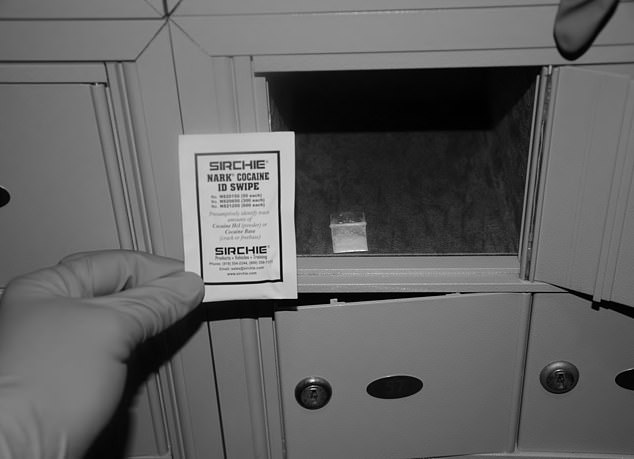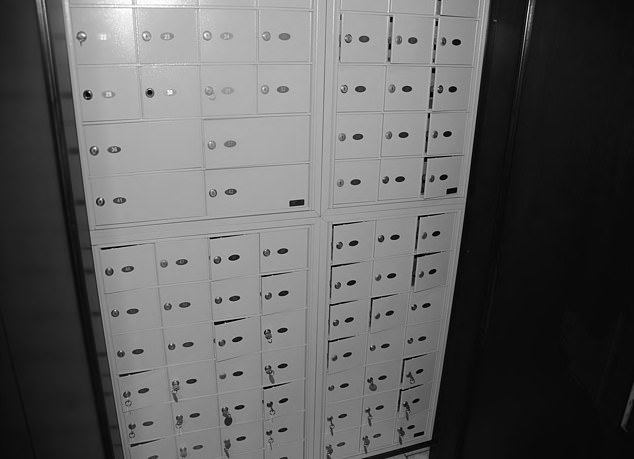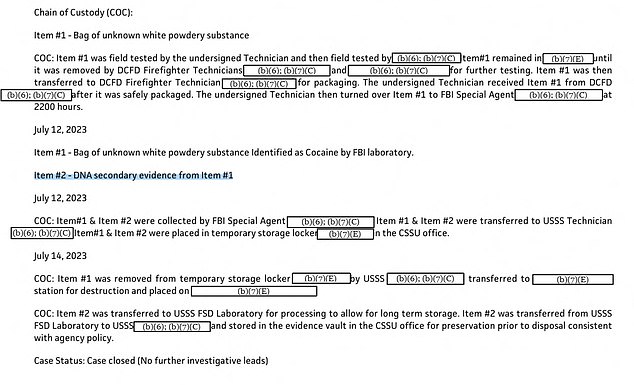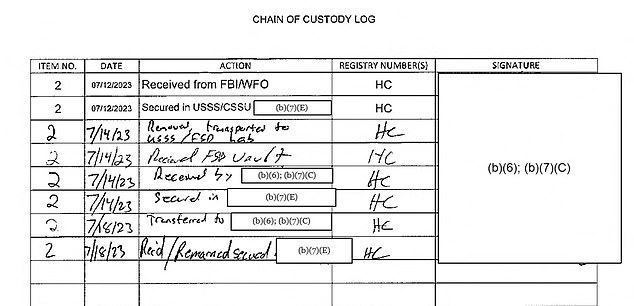Where is the key to locker 50 and does the Secret Service STILL have tubes of DNA? Ny Breaking breaks down all the unanswered questions after the bombshell release of the photos of the White House cocaine
The “key” to finding out who brought cocaine into the White House may depend on whether such an item is ever found.
While the biggest unsolved mystery about the cocaine is who got the bag through security and dumped a gram of drugs into locker No. 50, another outstanding question is what happened to the locker key.
The key was “reported lost” after the cocaine was discovered in the safe on July 2, according to Secret Service spokesman Anthony Guglielmi, sparking a weeks-long scandal over the summer.
Interest in cocaine-gate was renewed earlier this month when DailyMail.com became the first to publish images of the drugs from the White House.
Secret Service documents obtained through a Freedom of Information Act request also shed light on what evidence may still exist, as the bag of cocaine itself was destroyed a day after the 11-day investigation concluded.
The key to locker No. 50, where the cocaine was found, was “reported lost,” a Secret Service spokesperson told DailyMail.com

DailyMail.com was the first news organization to publish photos of the bag of cocaine found in White House Locker No. 50 on July 2.

Locker users put their things in the lockers and then take the keys. However, the key to Locker No. 50 was ‘reported lost’ following the discovery of cocaine on July 2
Buried within the 112 pages of documents turned over by the Secret Service is a reference to “Item #2,” which is described as “secondary DNA evidence from Item #1,” with Item #1 being the bag of cocaine itself.
In a document marked “Certified Inventory of Evidence,” item #2 is described as an “envelope containing (3) tubes.”
An expert DailyMail.com spoke to said these tubes likely contained the swabs or a cutting used to conduct the drug and DNA tests, but Guglielmi could not say for sure.
A Chain of Custody log noted that item #2 “remained secure” as of July 28.
The bag of cocaine was sent for destruction on July 14, one day after the investigation closed.
An additional unanswered question is whether that secondary piece of evidence still exists.
“I don’t know exactly what was in the tubes, but in terms of destruction, there is a retention schedule that must be followed and the time to preserve evidence depends on the type of evidence it is and the status of the case,” said Guglielmi. DailyMail.com.

A secondary piece of evidence may remain in the custody of the Secret Service. It was identified on another document as an envelope containing three tubes, likely containing the swabs used when researchers tested the drugs, and a bag.

This document notes that the second piece of evidence – which may still be in Secret Service custody – was an envelope containing three tubes

This document, which was part of DailyMail.com’s FOIA request, says the second “DNA evidence” “remained protected” as of July 18.
When asked if the timeline for the destruction of evidence was publicly available, Guglielmi responded, “That file that you have is all publicly available information.”
Wider, the name of the person who discovered the cocaine and the names of other law enforcement officers who worked on the case were redacted, making it difficult to find sources who could speak to what happened.
The list of suspects was reduced to 500, in part because there were no cameras directly recording the lockers.
Additionally, the lockers are not assigned to specific staff, but instead guests can choose a locker to use and then grab a numbered key.
It is also unclear whether any interviews were ever conducted – and if not, why they did not take place.
Staff who do not yet work in the West Wing and guests taking tours use the lockers. That’s why the suspect pool was so large.
A former Trump administration official thought the perpetrator was likely staff because “security is a little more lax.”
However, a more current White House source believed that someone taking a tour was the main culprit, because anyone who knows the White House would know that there is a bathroom just steps away – where the contraband could have been flushed.
In the days after the discovery, National Security Advisor Jake Sullivan put forward another theory: that’s a construction worker could have brought in the cocaine as it was found near the Situation Room, which was being renovated at the time.
“I would like to make a point about the Situation Room because I think there has been a lot of questionable reporting on this,” Sullivan said during a July 7 briefing. ‘The Situation Room is not in use and has not been in use for months as it is currently under construction.’
“We are using an alternate Situation Room in the Eisenhower Executive Office Building, so the only people entering and leaving the Sit Room during this time are employees preparing it for use,” he added.
